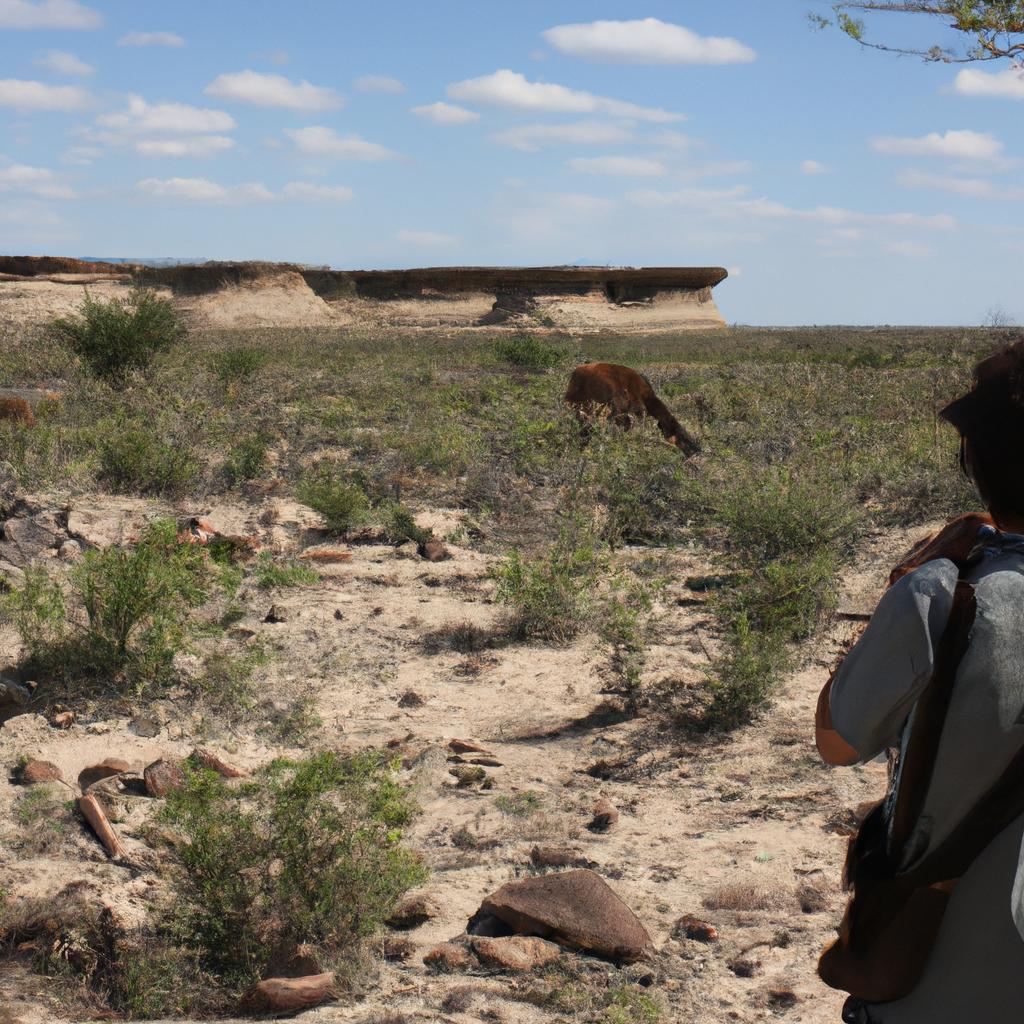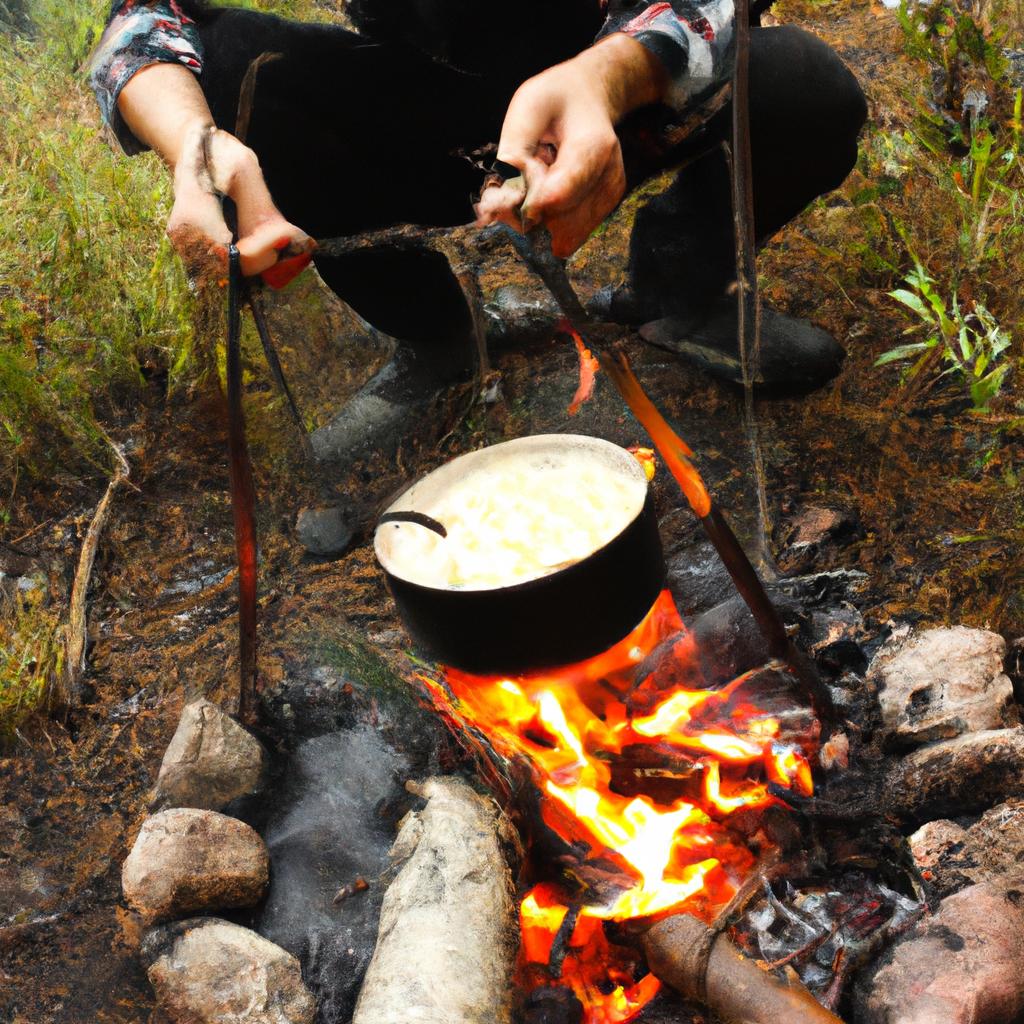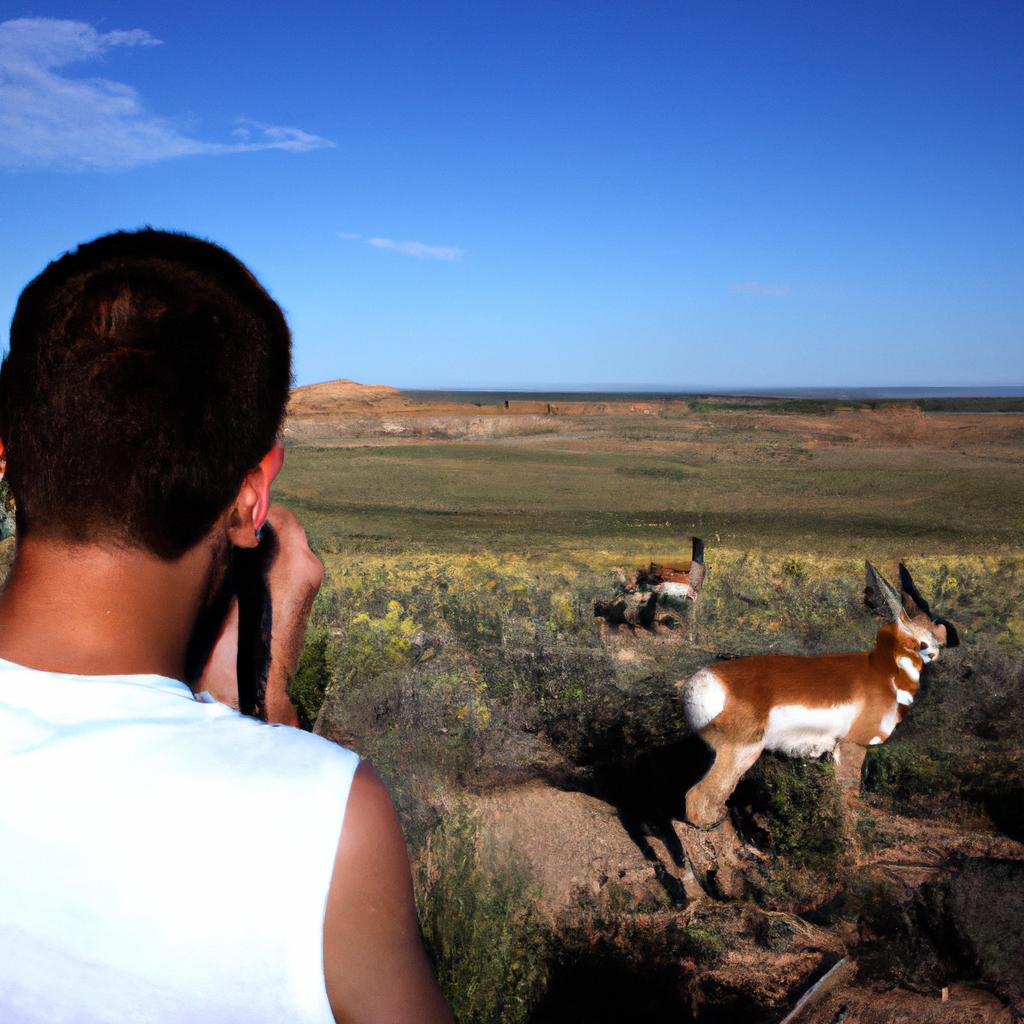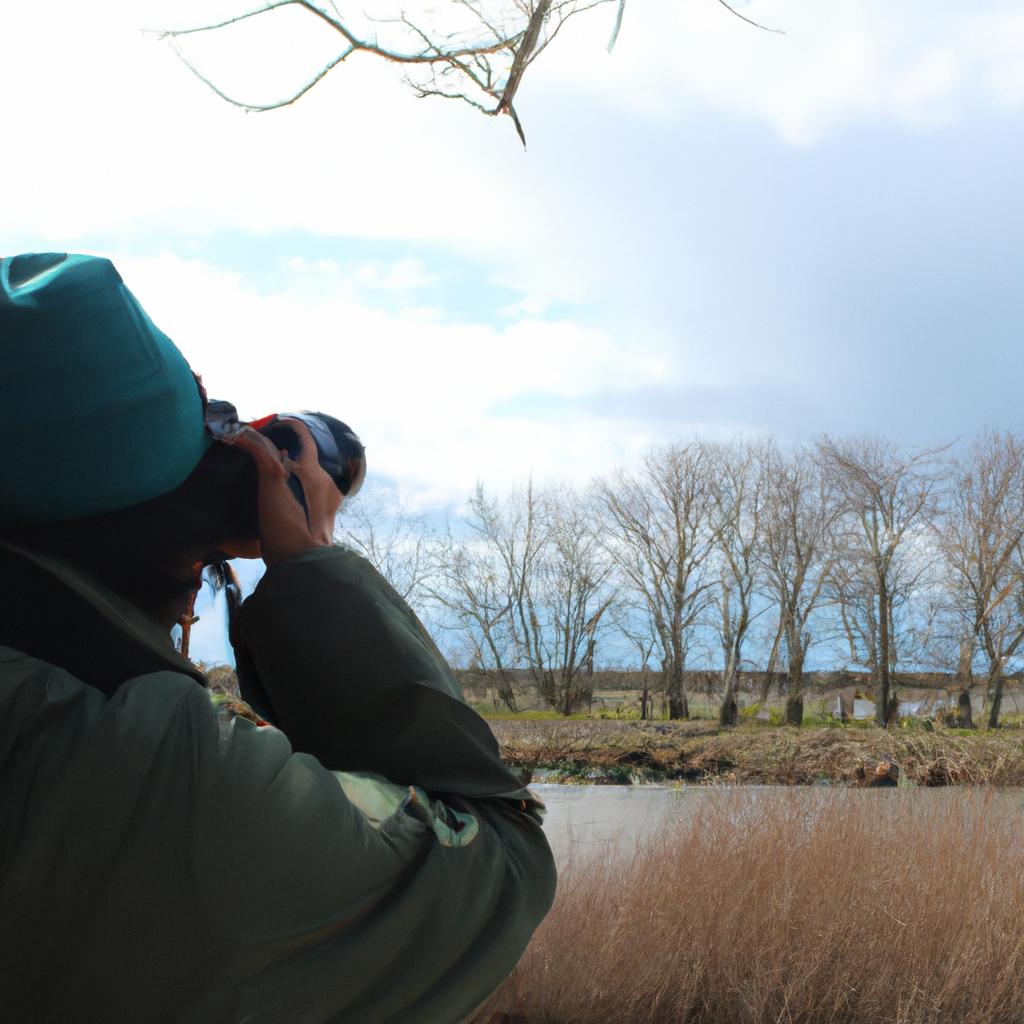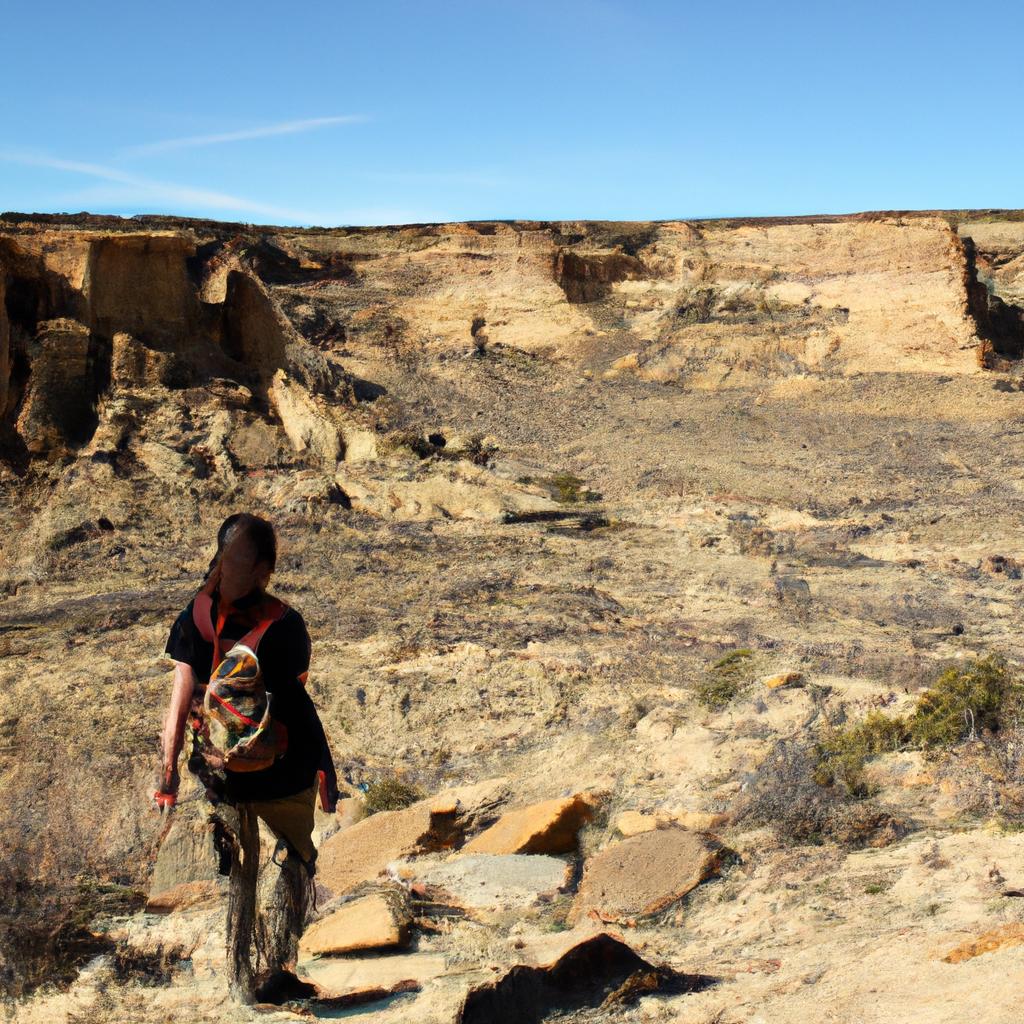Bird watching is a popular recreational activity, attracting enthusiasts from all over the world. One fascinating destination for bird watchers is Chaco Canyon, located in New Mexico, USA. This remote and isolated region offers an abundance of avian species, making it an ideal spot for observing and studying birds in their natural habitat. For instance, imagine witnessing the majestic flight of a golden eagle as it soars above the ancient ruins of Pueblo Bonito – such experiences are not uncommon in this unique landscape.
Chaco Canyon presents travelers with a multitude of opportunities to engage in bird watching while camping amidst its awe-inspiring scenery. However, planning a successful trip requires careful consideration and preparation due to its arid climate and limited facilities. This article serves as a comprehensive guide that aims to assist travelers interested in exploring the wonders of bird watching in Chaco Canyon by providing essential tips on camping logistics, recommended gear, and notable bird species found within this captivating environment. By following these guidelines, individuals can optimize their experience and maximize their chances of encountering some truly remarkable avian creatures during their visit to this extraordinary location.
Exploring Chaco Canyon’s Diverse Bird Species
Imagine standing amidst the ancient ruins of Chaco Canyon, surrounded by breathtaking landscapes and immersed in the diverse world of bird species that inhabit this remarkable area. One such example is the majestic Peregrine Falcon (Falco peregrinus), known for its incredible speed and agility during flight. This captivating scenario exemplifies the rich avian diversity found within Chaco Canyon.
To fully appreciate the variety of bird species in Chaco Canyon, it is essential to understand their habitats and ecological niches. The region’s unique combination of desert vegetation, towering cliffs, and mesas creates an ideal environment for numerous avian inhabitants. These birds have adapted over time to survive in arid conditions, relying on specific food sources and nesting grounds.
Let us delve deeper into some key characteristics that define the bird population in Chaco Canyon:
- Adaptations: Desert-dwelling birds possess remarkable adaptations to thrive in extreme environmental conditions. They have developed efficient water conservation mechanisms, specialized beaks for feeding on desert plants or insects, as well as intricate plumage patterns for camouflage.
- Migratory Patterns: Some birds residing in Chaco Canyon are migratory, making their presence transient throughout the year. Their arrival and departure coincide with specific seasons when resources become scarce or abundant elsewhere.
- Nesting Habits: Birds exhibit a range of nesting habits within Chaco Canyon. While some construct elaborate nests atop rocky ledges or within crevices, others utilize shrubs or cacti as protective coverings.
- Feeding Strategies: The diverse array of plant life within Chaco Canyon provides various food sources for resident birds. From nectar-sipping hummingbirds to seed-eating finches, each species has evolved distinct feeding strategies based on available resources.
To better comprehend these aspects, refer to the following table highlighting notable bird species commonly observed in Chaco Canyon, their preferred habitats, and distinctive characteristics:
| Bird Species | Preferred Habitat | Distinctive Characteristics |
|---|---|---|
| Peregrine Falcon | Cliffs and Canyons | Exceptional speed during flight |
| Gambel’s Quail | Desert Scrub | Ornate plumage patterns for camouflage |
| Black-Throated Sparrow | Open Grasslands | Striking black throat patch |
| Western Screech-Owl | Cottonwood Groves | Nocturnal hunting behavior |
By appreciating the adaptations, migratory patterns, nesting habits, and feeding strategies of Chaco Canyon’s bird species, one can embark on a captivating adventure to explore this remarkable avian world. In the subsequent section, we will discuss the best times of the year for bird watching in Chaco Canyon.
Best Times of the Year for Bird Watching in Chaco Canyon
Continuing our exploration of Chaco Canyon’s avian wonders, let us now turn our attention to understanding when optimal conditions align for an unforgettable bird watching experience.
Best Times of the Year for Bird Watching in Chaco Canyon
As we delve deeper into the world of bird watching in Chaco Canyon, it is important to understand the remarkable diversity of avian species that call this unique region home. To illustrate this point, let us consider a hypothetical scenario: imagine an avid birder named Jane who traveled to Chaco Canyon during the spring migration season. Armed with her binoculars and field guide, she embarked on a mesmerizing journey through the canyon’s ancient ruins and striking landscapes.
One cannot discuss bird watching without acknowledging the emotional connection it fosters between observers and their surroundings. Here are a few reasons why exploring Chaco Canyon’s diverse bird species can evoke such profound emotions:
- Witnessing majestic raptors soar across expansive skies.
- Delighting in the vibrant colors of warblers as they flit among desert shrubs.
- Experiencing awe at the intricate melodies sung by songbirds at dawn.
- Marveling at flocks of migratory birds staging together before embarking on long journeys.
To provide further insight into Chaco Canyon’s rich avifauna, refer to the table below showcasing some notable bird species found within its boundaries:
| Common Name | Scientific Name | Conservation Status |
|---|---|---|
| Western Tanager | Piranga ludoviciana | Least Concern |
| Black-throated Sparrow | Amphispiza bilineata | Least Concern |
| Prairie Falcon | Falco mexicanus | Near Threatened |
| Lazuli Bunting | Passerina amoena | Least Concern |
In conclusion, immersing oneself in the fascinating world of bird watching in Chaco Canyon offers not only intellectual enrichment but also emotional fulfillment. The sight of various avian species thriving amidst this arid landscape serves as a testament to nature’s resilience and adaptability. In our next section, we will explore the essential bird watching equipment you should consider bringing for your upcoming trip to Chaco Canyon.
Essential Bird Watching Equipment for Your Trip
Bird Watching in Chaco Canyon: A Traveler’s Guide to Camping
Section 2: Best Times of the Year for Bird Watching in Chaco Canyon
But before we do, consider this hypothetical scenario: imagine yourself standing amidst the arid landscape of Chaco Canyon, as a vibrant and colorful Western Tanager flits through the desert scrub. This is just one example of the awe-inspiring encounters that await those who venture into this remarkable bird-watching destination.
To ensure you are fully equipped for your adventure, here is a list of essential bird watching equipment that should accompany you on your journey:
- Binoculars: Invest in a good pair of binoculars with high magnification power and excellent clarity to bring these beautiful creatures closer.
- Field guidebook: Carry a comprehensive field guidebook specific to birds found in Chaco Canyon. It can be an invaluable resource when identifying species during your observations.
- Camera or smartphone with zoom lens: Capture stunning images or record videos of rare sightings that may leave lasting memories even after you return home.
- Comfortable clothing and footwear: Wear lightweight and breathable clothing suitable for outdoor activities while ensuring sturdy shoes provide adequate support during long hikes.
Furthermore, take note of the following table highlighting some notable bird species commonly spotted in Chaco Canyon throughout different seasons:
| Season | Notable Species | Migration Patterns |
|---|---|---|
| Spring | Black-throated Sparrow | Migratory passerines |
| Summer | Gambel’s Quail | Resident species |
| Fall | Peregrine Falcon | Southbound migrations |
| Winter | Golden Eagle | Winter visitors |
As you can see, each season in Chaco Canyon offers unique avian experiences. From the arrival of migratory species in spring to the majestic winter visitors, every moment presents an opportunity for bird enthusiasts to witness a diverse array of feathered wonders.
In our next section, we will explore some of the top bird-watching spots within Chaco Canyon and delve into the intricacies of observing these remarkable creatures in their natural habitat. So let us now turn our attention towards these captivating locations that await your exploration.
Top Bird Watching Spots in Chaco Canyon
Bird Watching in Chaco Canyon: A Traveler’s Guide to Camping
Having the right equipment is vital for a successful bird watching trip in Chaco Canyon. With its diverse avian population, you won’t want to miss any opportunity to observe these magnificent creatures up close. In this section, we will discuss the essential gear that every aspiring bird watcher should have.
Imagine you’re standing on a cliff overlooking the vast expanse of Chaco Canyon. As you scan the horizon with your binoculars, a flash of color catches your eye – it’s a vibrant Vermilion Flycatcher perched on a nearby branch. To ensure you don’t miss such encounters, consider investing in high-quality binoculars. Optics with good magnification and clarity are essential for identifying birds from afar.
To capture those breathtaking moments when an elusive species graces your presence, carrying a camera with telephoto capabilities can be immensely rewarding. With the advancements in digital photography, even amateur photographers can now document their observations with stunning detail. Consider lenses with long focal lengths to bring distant birds closer without disturbing them.
Furthermore, having field guides specific to the region will enhance your experience by providing valuable information on various bird species found in Chaco Canyon. These guides often include detailed descriptions, maps indicating common habitats, and illustrations or photographs for accurate identification.
When venturing into nature reserves like Chaco Canyon, it’s crucial to prioritize comfort and safety during extended hours outdoors. Here are some additional items worth considering:
- Comfortable clothing suitable for changing weather conditions
- Sturdy footwear for walking along trails and rugged terrain
- Sunscreen and insect repellent to protect against harsh sun rays and pesky bugs
- Water bottles or hydration packs to stay hydrated throughout your explorations
As you prepare yourself with the necessary gear outlined above, remember that observing birds in their natural habitat provides not only entertainment but also a deeper connection with nature. By respecting their environment and abiding by ethical birding practices, you can contribute to the conservation efforts for these magnificent creatures.
Discover where you’re likely to encounter some of the most remarkable avian species this region has to offer.
Tips for Identifying Common Bird Species in the Area
Picture this: as you step into Chaco Canyon, your eyes are immediately drawn to a vibrant flash of color against the desert landscape. A small flock of Western Tanager birds flits among the ancient ruins, their bright yellow bodies contrasting sharply with the earthy tones of the canyon walls. This is just one example of the incredible bird diversity that can be found within Chaco Canyon’s unique habitats.
To fully appreciate and explore these fascinating avian ecosystems, it is essential to understand the different types of bird habitats present in Chaco Canyon. Here are three key habitats that provide distinct opportunities for observing and studying birds:
-
Riparian Areas: These lush areas along rivers and streams offer an oasis-like environment for both resident and migratory species. As you traverse through cottonwood groves and willow thickets, keep an eye out for elusive waterfowl such as American Wigeons and Mallards. The sound of rushing water provides a soothing backdrop to your bird-watching experience.
-
Pinyon-Juniper Woodlands: Spread across vast expanses, these woodlands consist mainly of pinyon pine and Utah juniper trees. They serve as home to various songbirds like Mountain Bluebirds, Juniper Titmice, and Black-throated Gray Warblers. In springtime, witness male Lazuli Buntings singing from elevated perches while performing acrobatic displays to attract potential mates.
-
Open Grasslands: With wide-open spaces stretching far beyond what meets the eye, grassland areas house several raptor species including Red-tailed Hawks and Northern Harriers. You may also spot ground-nesting birds like Lark Sparrows or Horned Larks camouflaged amidst the tall prairie grasses.
Now that we have explored some of Chaco Canyon’s distinct bird habitats let us delve deeper into understanding the different bird species that call this area their home. The next section will provide you with valuable tips for identifying common birds found in Chaco Canyon, enhancing your overall bird-watching experience.
- Discover the hidden treasures of avian life within Chaco Canyon.
- Immerse yourself in the serene beauty of riparian areas and witness vibrant waterfowl species.
- Journey through pinyon-juniper woodlands, where melodious songbirds fill the air with enchanting melodies.
- Explore expansive grasslands and catch sight of majestic raptors soaring high above.
Emotional Table:
| Habitat | Bird Species | Unique Characteristics |
|---|---|---|
| Riparian Areas | American Wigeons | Vibrant green speculum on wings |
| Mallards | Bright blue wing patches | |
| Pinyon-Juniper Woodlands | Mountain Bluebirds | Vivid sky-blue plumage |
| Juniper Titmice | Distinct crest atop head | |
| Open Grasslands | Red-tailed Hawks | Broad wingspan and rusty-red tail |
| Northern Harriers | White patch on base of tail |
As we continue to explore the wonders of bird watching in Chaco Canyon, it is crucial to emphasize the importance of conservation and respect for these remarkable creatures. By understanding their habitats, behaviors, and needs, we can ensure a sustainable future for both birds and humans alike. In the subsequent section about “Conservation and Respect for Birds in Chaco Canyon,” we will delve into practical steps individuals can take to protect these invaluable avian ecosystems without causing harm or disruption.
Conservation and Respect for Birds in Chaco Canyon
Tips for Bird Photography in Chaco Canyon
As you venture deeper into the world of bird watching in Chaco Canyon, it’s only natural that you may develop an interest in capturing these majestic creatures through photography. Photographing birds can be a challenging yet rewarding experience, allowing you to document their beauty and behavior. To help you make the most of your bird photography endeavors, here are some useful tips:
-
Patience is key: Birds can be skittish and easily startled by sudden movements or loud noises. Take your time and find a comfortable spot where you can observe them without causing any disturbances. Remember, great shots often require waiting patiently for the perfect moment.
-
Learn their habits: Understanding the behavior and habits of different bird species will significantly enhance your chances of capturing stunning photographs. Study their feeding patterns, preferred habitats, and nesting behaviors to anticipate their actions and position yourself accordingly.
-
Use appropriate equipment: Invest in a good telephoto lens that allows you to capture distant subjects without disturbing them. A tripod or monopod can also come in handy when shooting from long distances, providing stability and reducing camera shake.
-
Respect their space: While getting closer to birds might seem tempting for better shots, it’s crucial to respect their personal space. Approaching too closely can cause unnecessary stress or even disrupt their natural activities like feeding or breeding.
Markdown Bullet Points:
- Observe quietly without making sudden movements
- Research specific times of day when certain species are more active
- Experiment with different angles and perspectives
- Practice using burst mode to capture fast-paced action
Markdown Table:
| Equipment | Pros | Cons |
|---|---|---|
| Telephoto Lens | Great zoom capabilities | Can be heavy |
| Tripod/Monopod | Provides stability | May limit mobility |
| Burst Mode | Captures fast action | Requires more memory space |
By following these tips, you will not only enhance your bird photography skills but also develop a deeper appreciation for the avian wonders that inhabit Chaco Canyon. So grab your camera and embark on an exciting journey to capture the beauty of these feathered creatures in their natural habitat.


